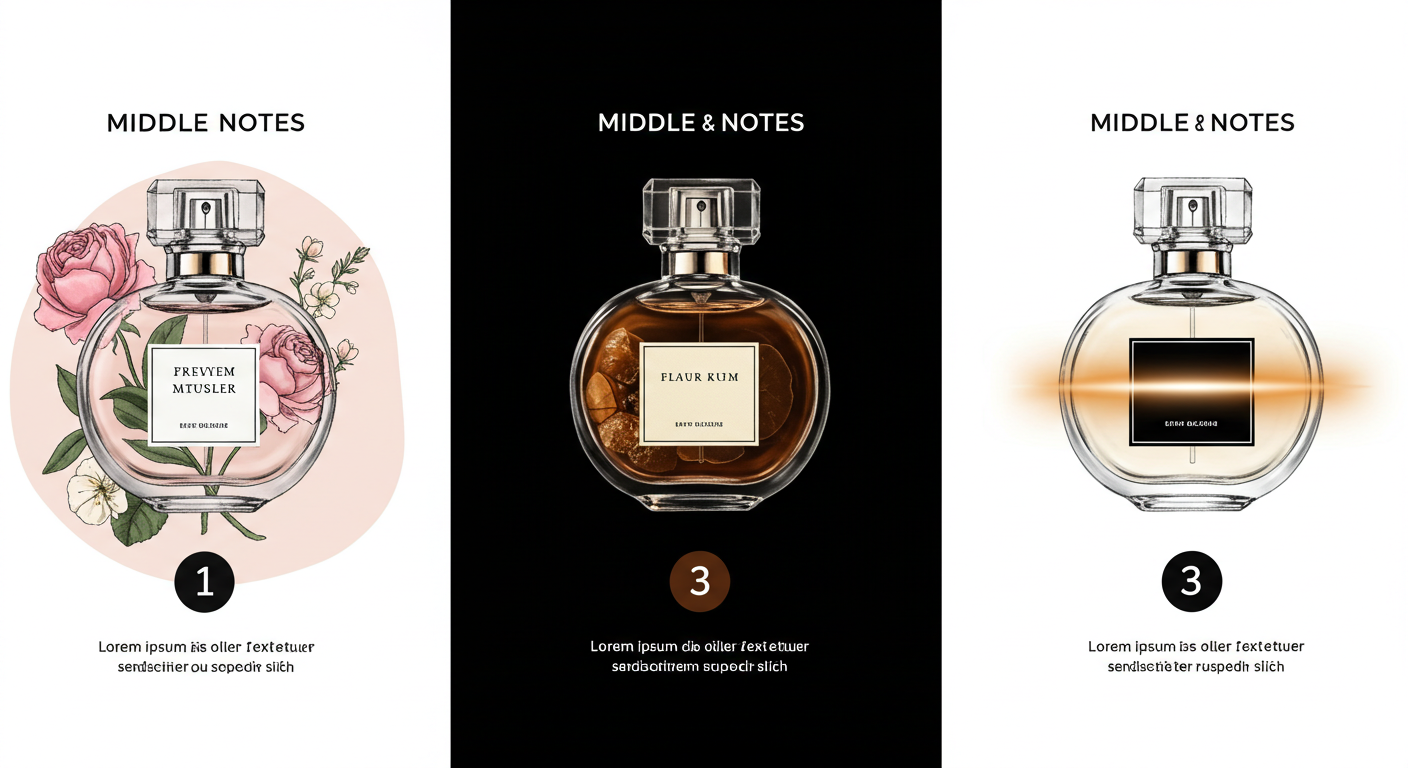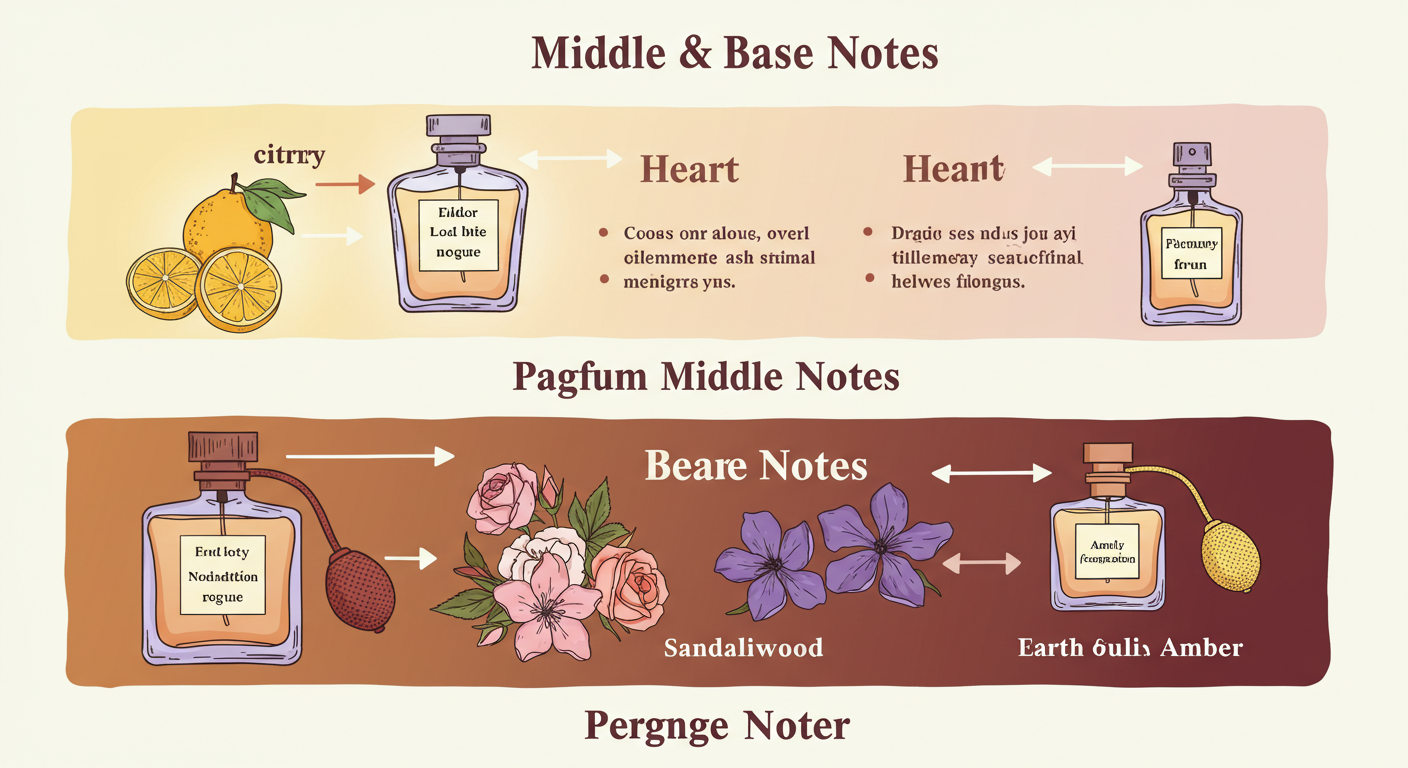Table of Contents
The world of perfume is a captivating blend of art and science, where a single spritz can evoke memories, emotions, and even transport you to far-flung destinations. But have you ever wondered what makes up the magic behind your favorite fragrances?
Perfume, at its core, is all about layers of scent, which are divided into three categories: top notes, middle notes, and base notes. These layers work harmoniously to create the complexity and depth we love in perfumes.
If you’ve been curious about “what are top, middle, and base notes in perfume”, this guide will help you unravel the mystery. By the end of this blog, you’ll not only understand the difference between top, middle, and base notes in perfume but also gain practical tips to identify these in your favorite fragrances.
Get ready to refine your scent knowledge and become a fragrance connoisseur!
What Are Perfume Notes and Why Do They Matter?
Perfume notes can best be described as the layers or components of a scent that unfold over time. Each note interacts with the others to build the complete fragrance profile. Without these distinct layers, perfumes would lack the complexity that makes them so alluring.
These three levels of perfume notes work together to create a timeline for the scent’s lifespan. First, you experience the top notes, followed by the richer middle notes, and finally, the long-lasting base notes. Together, they dictate how a fragrance smells when first applied, how it develops as it dries, and how it lingers through the day.

But why do perfume notes matter? They aren’t just technical jargon for perfumers; they significantly influence how a scent feels, lasts, and interacts with your body chemistry. Whether you’re a beginner or a seasoned fragrance lover, understanding perfume notes will empower you to choose scents that perfectly suit your preferences, mood, and occasion.
Now, let’s break down these three categories and explore what makes them unique.
Top Notes
Think of top notes as your perfume’s first impression. These are the notes you experience immediately after spraying a fragrance. Often light, crisp, and fresh, top notes are designed to grab attention and set the tone for what’s to come.
Characteristics of Top Notes
- Volatility: Top notes are the most volatile, meaning they evaporate the fastest. Typically, they last only 10–20 minutes.
- Fresh and Inviting: They are often described as uplifting and zesty, drawing you into the scent.
- Purpose: The role of top notes is to create an immediate impact and intrigue the wearer to continue exploring the fragrance.
Common Examples of Top Notes
- Citrus: Lemon, bergamot, orange, grapefruit
- Fruits: Apple, pear, berries
- Herbs: Mint, basil, lavender, eucalyptus
- Light Spices: Pink pepper, cardamom
Top Notes Perfume List
Here are a few examples of fragrances known for their striking top notes:
- Dior Sauvage (bergamot, pepper)
- Jo Malone Lime Basil & Mandarin (lime, mandarin)
- Chanel Chance Eau Tendre (grapefruit, quince)
Middle Notes
When the top notes softly fade, the fragrance’s heart reveals itself, and in the perfume world, this is known as the middle notes (or heart notes). These are the core of the fragrance and often make up the majority of the scent profile.
Characteristics of Middle Notes
- Longevity: Middle notes last much longer than top notes, usually lingering for 1–3 hours.
- Balanced and Complex: They are richer and more complex, providing depth and character.
- Purpose: Often called the “heart” of a scent, middle notes help bridge the fresh top notes and the grounding base notes.
Common Examples of Middle Notes
- Floral: Rose, jasmine, ylang-ylang, geranium
- Fruits: Peach, apricot, plum
- Spices: Cinnamon, clove, nutmeg
- Greens: Tea leaves, violet leaves
What Is the Middle Note in Perfume?
Middle notes are where most of the artistry in perfume-making resides. They add personality to the fragrance and are usually the notes you’ll identify when someone compliments or asks about your perfume.
Middle Notes Perfume List
Here are some iconic scents with lovely middle notes:
- Marc Jacobs Daisy (jasmine, rose)
- Tom Ford Black Orchid (spices, floral accords)
- Miss Dior Blooming Bouquet (pink peony, damask rose)
Base Notes
Finally, we arrive at base notes, the foundation of every perfume. Base notes give a fragrance its longevity and depth, anchoring the lighter top and middle layers.
Characteristics of Base Notes
- Lasting Power: Base notes emerge slowly, often after the perfume has dried down, and can last from several hours to all day.
- Richness and Warmth: These notes are typically deep, earthy, and grounding.
- Purpose: They serve as the scent’s foundation, providing depth and helping the fragrance adhere to the skin.
Common Examples of Base Notes
- Woods: Sandalwood, cedarwood, patchouli, vetiver
- Resins: Amber, benzoin, myrrh
- Vanillas & Sweet Notes: Vanilla, tonka bean, chocolate
- Animalics (synthetic in modern perfume): Musk, leather
Base Notes Perfume Meaning
Base notes are the unsung heroes that give weight and dimension to a scent. They’re responsible for the lingering “signature” that people often recall fondly long after you’ve left the room.
Base Notes Perfume List
Examples of perfumes with outstanding base notes:
- Chanel Coco Mademoiselle (patchouli, vanilla)
- Yves Saint Laurent Black Opium (vanilla, coffee, cedarwood)
- Guerlain Shalimar (tonka bean, leather, incense)
How Perfume Notes Interact and Create a Fragrance Profile
Now that you understand the unique qualities of top, middle, and base notes, it’s time to see how they work together. Perfumers craft fragrances by carefully blending these layers to ensure a smooth progression from one note to the next. The resulting fragrance pyramid gives depth, complexity, and balance to every bottle of perfume.
For example:
- A perfume might open with a zesty grapefruit top note, transition to a floral and juicy peach middle note, and settle into a creamy vanilla and cedarwood base.
- Each interaction shapes the perfume’s character, determining whether it feels youthful and playful or deep and sensual.
Tips for Identifying Notes in Your Favorite Perfumes
Want to take your scent knowledge to the next level? Here are a few tips to help you pick out individual notes in a perfume:
- Start Simple: Begin with single-note essential oils like lavender or citrus to train your nose.
- Spray and Sniff: Apply the perfume on your skin, then note how it smells after the first few seconds, 15 minutes, and a few hours later.
- Use Tasting Notes: Check the label or product description for guidance. Perfumer-provided tasting notes often help pinpoint specific aroma layers.
- Try Fragrance Families: Explore categories like florals, orientals, or woody scents to get a better feel for complementary notes.
Unlock the Secrets of Perfume
Perfume is more than a fragrance; it’s an experience, a mood, and a story. Understanding what are top, middle, and base notes in perfume allows you to appreciate the craftsmanship behind every bottle.
Next time you’re shopping for perfume, remember the balance that top, middle, and base notes provide when choosing a scent. Experiment with different fragrances, take note of the base notes perfume list or middle notes perfume list that appeals to you, and don’t forget to savor the experience of each layer.
If you’re curious about deciphering the fragrance pyramid further or want tips for layering scents, check out our full guide. Remember, your perfect scent is waiting to be discovered!













